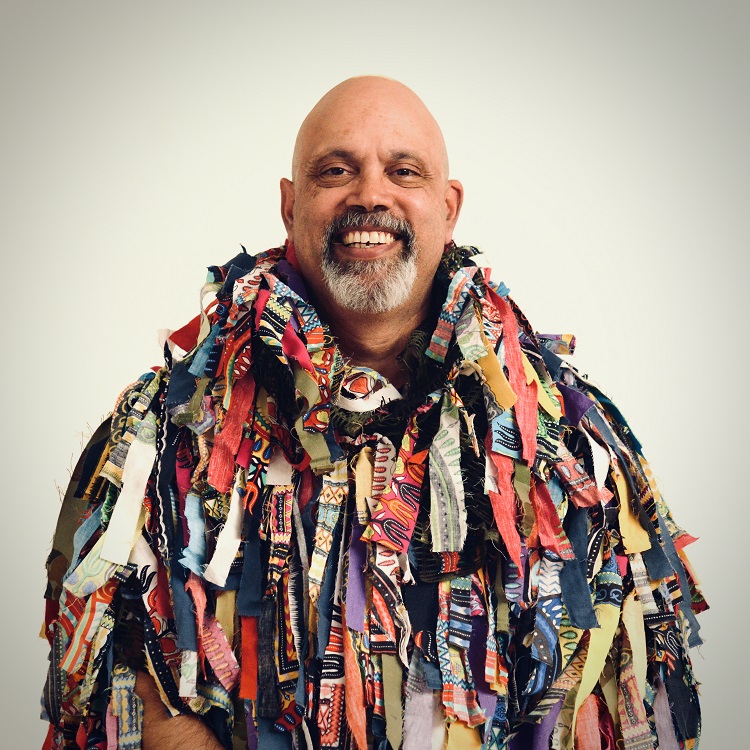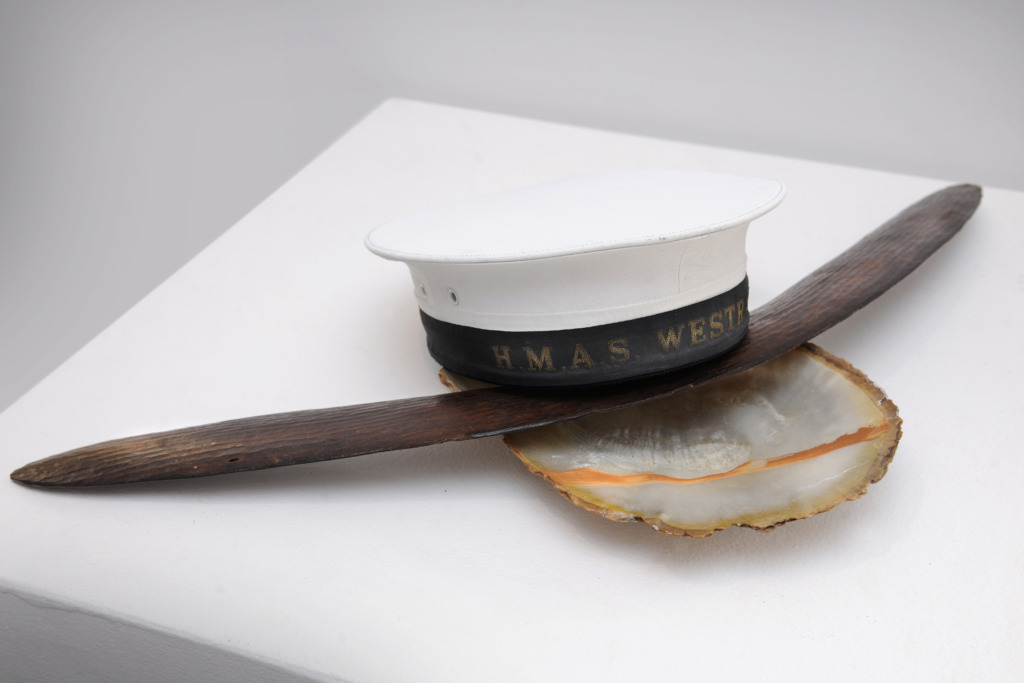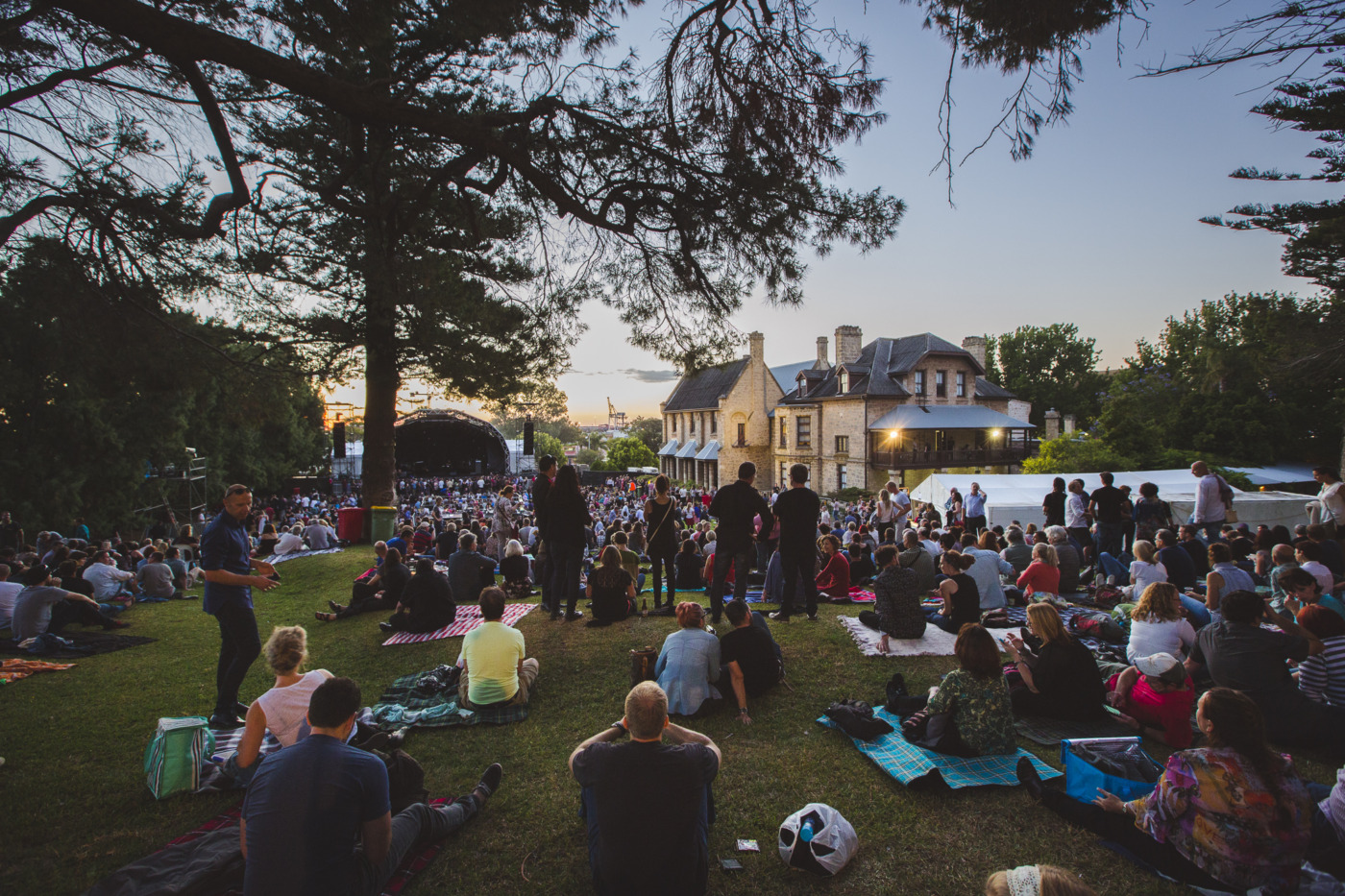
Ron Bradfield wearing his artwork In Plain Sight, 2019. Photography by Sue-Lyn Aldrian-Moyle
About the artist
Bard Peoples, Western Australia
Born 1968, Northampton, Nhanda Country, Western Australia
Lives and works Walyalup | Fremantle, Whadjuk Boodja, Western Australia
![]() @ronbjnr
@ronbjnr
Ron Bradfield is a saltwater man from Bard Country in Broome who grew up in Geraldton. He now calls Whadjuk Boodjar (Perth) his home. As the CYO (Chief Yarning Officer) of Yarns R Us; Ron facilitates cultural conversations across all levels of our communities, helping Australians explore their own personal stories and connection to place.
Ron is also a storyteller and artist, having worked in and around the arts across regional and metropolitan WA for 15 years, often supporting the development of artists to strengthen their creative practices.
Works for sale
A selection of Ron’s Undertow works are available to purchase. Visit our sales page for details.
CURATOR’S REFLECTIONS: RON BRADFIELD
Ron Bradfield is a storyteller and for many years telling stories and spinning yarns has been his primary artistic medium, weaving words and conversations with generosity, humour, charm, and wit to share stories of his life and those of his loved ones. He does this in a way that opens the hearts, minds, and mouths of those in his company – creating space for everyone to listen and to share, but most importantly he holds space for people to feel – to feel joy or sadness and to feel safe in revealing their own stories.
In recent years Ron has explored new modalities of storytelling, working as a visual artist, and creating works which chronicle his own life experiences. This is familiar territory for Ron, having worked alongside artists for many years supporting them to share their unique understandings of the world. For Ron, however, the making process is one of much consideration and reflection and can sometimes be a space of unease as he continues to navigate two worlds, often at odds with each other. Like so many First Nations people, Ron exists in two versions of Australia, Indigenous and non-Indigenous, and manoeuvres both simultaneously every day of his life.
Born in Northampton in 1968, Ron was raised in Geraldton, at a challenging time for First Nations people in Australia. This was a time of social and cultural change and while Indigenous Australians were being afforded more rights in society, these changes to policy and national attitude did not result in meaningful change in Ron’s life in the 1970 and 80s.
I took part in a schooling through the 70’s and 80’s that reinforced the continued separation of our peoples in this society. It may not have always done so physically (and in my early years it did) but it continued to do so in such a way, that there was absolutely no doubt in any Aboriginal child’s mind about how much they were worth, to an Australian society.
After leaving school in 1985 and after the crushing realisation that to live in Australia he would need to be someone else, someone palatable and not an Aboriginal man, Ron joined the Royal Australian Navy. For Ron as a Bard man, a saltwater man from the Dampier Peninsula of the west Kimberley, he felt that in donning a revered naval uniform he could be accepted in society, he could be ‘one of its Australian men’. In some ways Ron made a temporary exchange of one saltwater identity for another. As a crewmember of the HMAS Westralia, Ron belonged to a family of men and women from all walks of life, a community that endured hardships and pain together. One incredibly challenging event was an engine room fire on board in 1998, a year after Ron had left the navy. This fire resulted in the loss of four lives and the emotional and physical injury of many crew members. Watching on from a distance, Ron felt despair and helplessness for his shipmates.
HMAS Westralia is where I finally became an acceptable example of this society’s ‘man’. This happened completely at the cost of me becoming my own man. It’s where I went through our collective Westralia family’s saltwater law/lore and in doing so, I’d found myself a new tribe and a new place to be and to belong. This is where I developed life-long bonds with those who kept me safe and alive at sea. This is where we lived our saltwater lives in each other’s smell. As a result, this is where some of my deepest and rawest scars were made.
It has been 25 years since Ron wore the tally band of the HMAS Westralia, but the experiences, good and bad have left him permanently changed. For Ron, these experiences were formative, they allowed him to belong to a community, to have purpose and to connect with saltwater country, albeit through the lens of service. There was, however, a point in time when Ron had to reconnect with family, community and Country, a process that continues to this day.
The ambitious works exhibited in Undertow, including the newly commissioned work A Ship’s Crew (2022) are a record, a kind of manifesto, bringing together and reconciling Ron’s life to date. The works honour those two saltwater families and saltwater stories, paying tribute to ancestors and comrades whose struggles and triumphs have inscribed themselves into his own story, into his being. The works comprising this installation are reverential, honouring symbols and icons from his saltwater worlds with mindful and respectful consideration. Functioning as artwork and personal museum, the works sit in a state of poetic balance rather than competing with each other, a reflection of Ron’s personal sense of resolve, looking back to his past.
‘It feels like that ship’s number is branded on my Liyan (my centre of self) permanently a part of my make-up and constantly reminding me of how I came to become a ‘man’ in this ‘Australian’ society’
Glenn Iseger-Pilkington, 2022
CALL & RESPONSE: ‘BARDI MAN’, BY CASS LYNCH
The following text was commissioned for Undertow, as a response to the narratives, themes, and ideas in Ron Bradfield’s recent works. Cass Lynch is a Nyoongar writer and researcher whose works explore deep time, climate change and ancestral knowledge. Find out more about Cass by visiting her website.
Off the coast of Noongar Country, a ship of iron moves in dark waters. It travels north, past the islands that were once hills in wide plains, long ago in the Cold Times. It passes the southern plains where tall white dunes roll down to clear seas, and limestone fingers reach up through sand, glowing in the moonlight. Further north, it moves beyond the bent trees of Geraldton, and passes Kalbarri where coastal sandstone meets the deep Murchison gorges, bands of red and orange, cut by the little blue river winding far below. The ship moves past the sandy spits of Shark Bay, where stingrays sleep amongst the shipwrecks on the ocean floor. It skirts the Norwest Cape, passing wide of the blue waters of Nyingulu; home to turtles, octopus, dolphins and rays. Continuing north, the iron in the ship’s hull sings softly as it passes the great iron heart of the Pilbara, and that ancient shield of ferrous rock rumbles tunelessly in return.
North of the ship, where the air is thicker and the coastline is hugged by mangroves and wattle thickets, the oysters of Bardi Country notice the iron visitor approaching. Here these flat discs of south sea oysters live in clutches on the sea floor, hints of moonlight pearlescence lining their shells as they take deep breaths of water. All the sea moves through oysters at one time or another, and they know the ship of iron is there, the metallic tang in the aqueous medium, that song of salt and alloy metal, with traces of diesel fuel in its wake.
The ship passes by Broome in the south, then Beagle Bay, then Lombadina, travelling up the Dampier Peninsula.
The oysters are not the only kin that have noticed the iron ship approaching. All of Bardi Country has stopped to watch the ship enter their waters. The bats in the mangroves glance toward it, the moths have paused from making spirals in the moonlight, the tree frogs are silent, listening. The shore birds lift their necks from nests, the dugongs line up in the shallows, facing west.
Shhhhhhrrrrrrssssh, frrrrsh. The ship is here.
The wind goes to investigate. It travels across waters which were dry land before the seas rose, not long ago. The sea can swallow people, homes, and histories, but it can also throw things up on the shore. Nothing is ever truly lost.
The wind arrives at the ship and discovers that it’s hatches and windows are all closed for the night. It circles around the bridge, looking in at the human faces lit with the red light emanating from the lamps and monitors. It finds a window ajar on the bridge wing and moves in and around the people staring out into the darkness. One person absent-mindedly flicks red dust off a keyboard; another shoos a moth away. The wind moves through the ship, searching, thinking, moving things around. Shaking a cup with a dried teabag stuck inside. Rattling a brass dog tag hanging from a lamp. Lifting a sock from a bag of dirty laundry.
The wind leaves a layer of material as it searches through the hallways, engine rooms and cabins. A sea eagle feather on a fuel drum. Charcoal in the handbasins. Seaweed pearls and barnacle shells amongst discarded food wrappers.
There’s something familiar here, but the wind can’t quite find it. The iron of the ship is singing a mournful song, but under that, the wind can hear the diesel fuel whispering too, singing softly of a time long ago when dinosaur bodies and decomposing ferns were pushed deep into the earth and became oil.
Pearl shell.
There is pearl light here somewhere. The wind rotates and moves towards the sleeping bodies in the bunks of the berth. Over, around, up, and across, the wind searches the beings lying flat in sleeping bags. A sleepy sigh. A shimmer in the gloom.
Pearl light.
There he is, the one who has been pulling the gaze of saltwater Country, craning the necks of bird, mammal, insect, fish and reptile. A man of this place, this Country. Gleaming with pearl light.
What are you doing out here, Bardi Man?
He is sleeping, and clothed in an unusual garb, dressed in the shades of someone else’s sea, his limbs swimming in a foreign dyed ocean. The wind looks him all over, dropping more pieces of Bardi Country as it does. Bee wrapped in spider web. Sea turtle eggshell. The bones of a fish. Ochre powder. This scatter settles into the stitching of his uniform, and the button indents, and the folds of the pants.
The wind wants to lift him away, but he won’t budge. The limbs move easily enough, the legs, the feet, the arms, the hands, they all rise under the winds’ pull. It’s the chest that is sunk like a stone into the soft bed. The heart is heavy, and the wind is just the wind, and cannot lift it.
The wind leaves the ship and blows back toward land, bringing with it the smell of diesel, disinfectant, cotton, and gunpowder.
Who has the power to sing this man home?
Four dingoes climb the dunes and stand there, looking across the seas, facing the ship. The wind moves through their fur and they recognise pearl shell amongst the scents.
They howl.
They howl,
they howl,
they howl.
The howls travel across the water in snaking spirals, tendrils of song looping toward the ship. The vibrational coils burst through the windows; enter up through the bilge; roll down through the exhaust stack. The howls rattle all through the iron ribs of the ship, vibrating, pulsating. They find the Bardi Man still asleep under a dusting of Country. The howls enter his clothes, wrap around his limbs. They move across his arms, his legs, his face, his chest, his back. They wrap around him like a layer of skin, pressing him, squeezing him. The howling envelops him in layers of memory, language, medicine and spirit. His skin is hidden under camouflage, but under the cotton, hair, fat and muscle; his femurs, vertebrae, tibia, ribs and fibula gleam like pearl shell. Softly, so softly, his Bardi bones howl back.
The coiling songs withdraw and the dingo vibrations move away through the ship; knocking hats off dressers, tipping tools from buckets, and flinging paper out of pigeonholes. They clatter out through the hatches into the night sky over Sea Country, dissipating under the stars. The ship travels on northward. The dingoes breathe deep on the dunes and settle as a group to sleep. In the shallows the oyster shells sigh and close themselves up, hiding their moonlight inside, for now.
Cass Lynch, 2022


